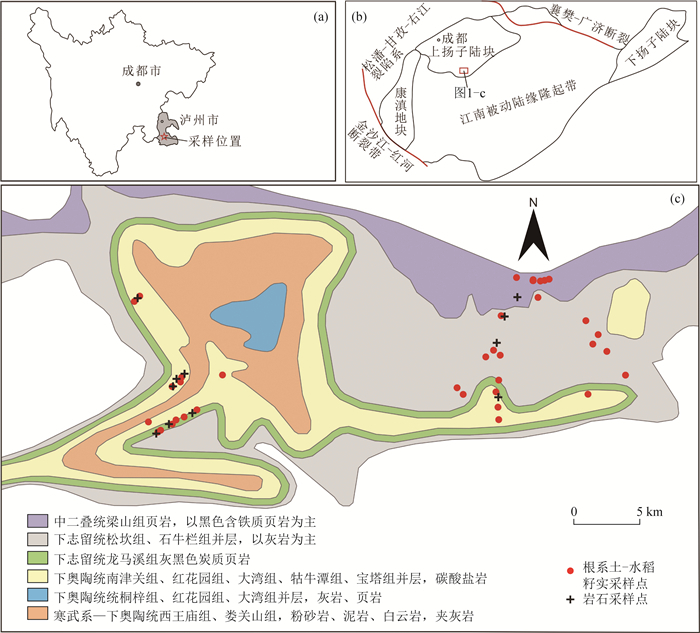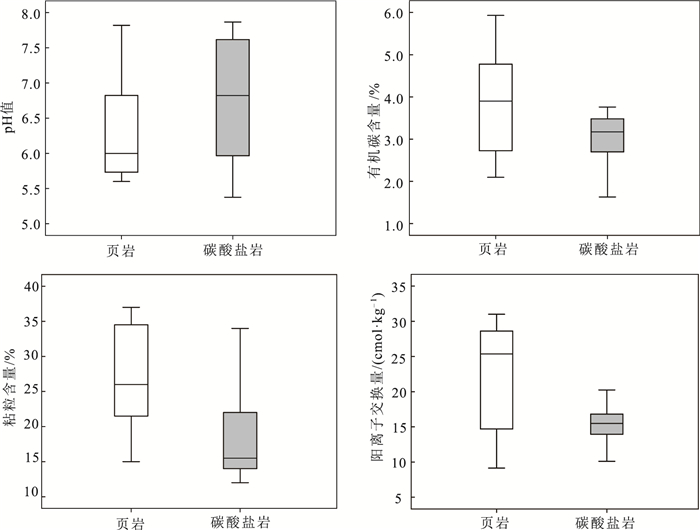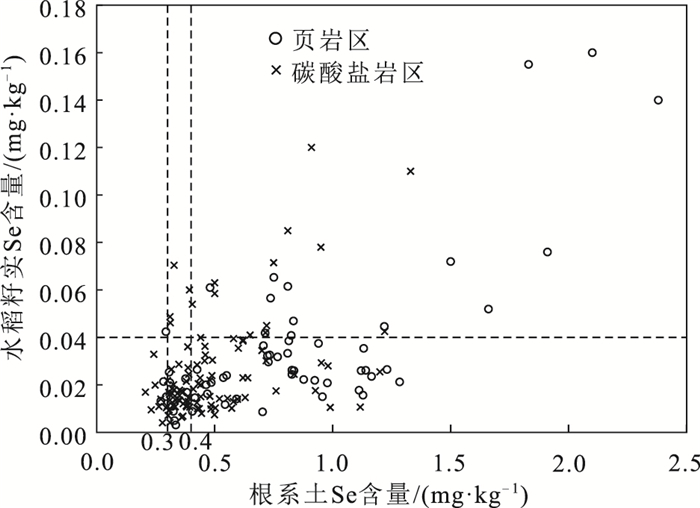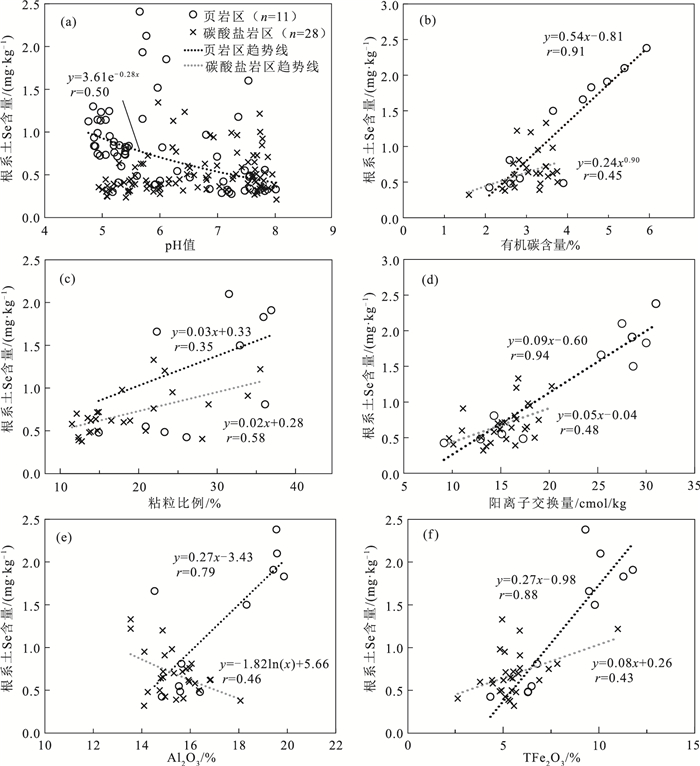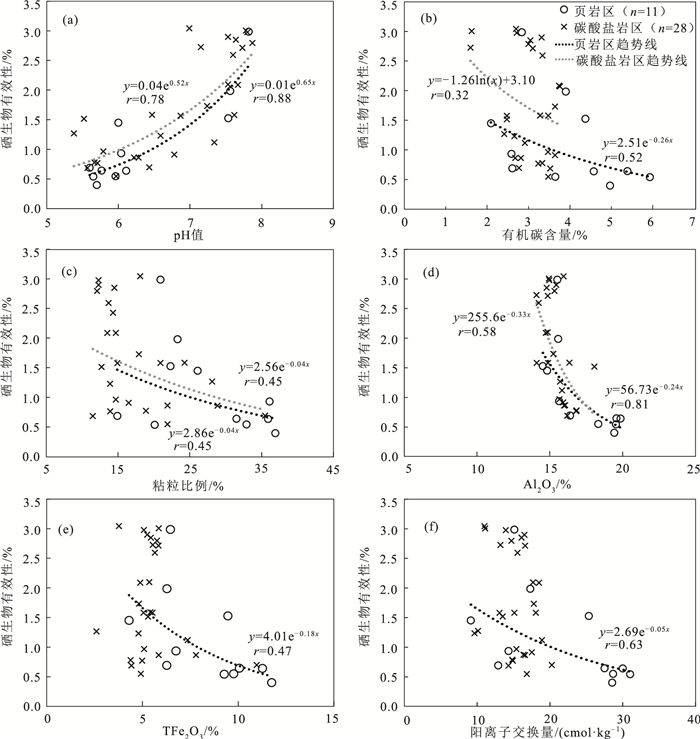Control factors of selenium content and bioavailability of rice root soil in shale and carbonate rock areas, Luzhou City, Sichuan Province
-
摘要:
以四川省泸州市碳酸盐岩和页岩分布区为研究区,开展了Se在成土母岩-根系土-水稻籽实体系中含量特征及迁移规律研究,丰富Se元素迁移转化理论,支撑服务富硒土地开发利用。研究结果表明,研究区页岩、根系土和水稻籽实Se含量分别为0.03~1.97 mg/kg、0.27~2.38 mg/kg和0.02~0.16 mg/kg,土壤硒以有机结合态(73%)和残渣态(25%)为主,有效态硒仅占0.69%。碳酸盐岩、根系土和水稻籽实Se含量分别为0.02~0.12 mg/kg、0.21~1.33 mg/kg和0.02~0.12 mg/kg,明显低于页岩区,土壤中有机结合态和残渣态硒所占比例高达97%,有效硒比例(1.58%)高于页岩区土壤。成土母岩的矿物组成和化学成分、Se含量及赋存形式对土壤性质和Se含量具有一定的控制作用。有机质、粘土矿物和pH值是土壤Se含量和生物有效性的主要控制因素。有机质和粘土矿物对硒的强烈吸附作用是研究区土壤富硒但生物有效性低的主要原因;pH值降低导致土壤胶体对硒的吸附能力升高,使土壤Se含量升高,但硒生物有效性随pH值降低明显降低。综上所述,研究区土壤Se含量高但生物有效性低,因此水稻籽实Se含量并不高,富硒土地的开发利用不能仅以土壤全Se含量作为判别标准,应结合土壤性质及硒生物有效性综合考虑。
Abstract:The control factors of selenium content and migration rule in the parent rock-root soil-rice system in sedimentary rock areas (carbonate rock and shale) were studied to enrich the theory of selenium migration and transformation and further support the scientific utilization of selenium-rich land.The Se values of shale, corresponding soil and rice seed are 0.03~1.97 mg/kg, 0.27~2.38 mg/kg and 0.02~0.16 mg/kg, respectively, and carbonate rock, soil and rice seed show Se content of 0.02~0.12 mg/kg, 0.21~1.33 mg/kg and 0.02~0.12 mg/kg.The proportion of organic binding Se and residual Se in soil is up to 98%.The Se bioavailability of soil in shale area is 0.69%, which is lower than that in carbonate rock area (1.58%).The mineral and chemical compositions as well as content and modes of occurrence of Se in parent rocks play an important role in controlling physicochemical properties and Se content in soils.The content and bioavailability of Se in soil are predominantly controlled by soil pH and colloids.The strong adsorption of Se by organic matter and clay minerals is the main factor responsible for high content but low bioavailability of Se in soils.The decrease of pH results in the increase of Se adsorption by soil colloids and thus high Se content in soil.However, Se bioavailability shows a decrease trend with pH decreases.In summary, the soils in shale and carbonate rock areas show high content but low bioavailability of Se and consequently, low Se content in rice seed.Therefore, the total Se content in soils could not be regarded as the criterion for the exploration of Se-rich soil, and the soil properties and Se bioavailability should also be cautiously considered.
-
Keywords:
- Se content in soil /
- bioavailability /
- shale /
- carbonate rocks /
- soil properties
-
关于国际地层年表中的侏罗系/白垩系界线年龄,在21世纪80年代初国际地学界分别提出了144Ma和130Ma两种方案。英国剑桥大学Harland等[1]提出了侏系系/白垩系界线年龄为144Ma,是用“年龄平摊法”算出的;法国居里大学Kennedy等[2]根据各国海相地层中海绿石年龄的测定结果提出侏罗系/白垩系界线年龄为130Ma [3](包括世界各国20个实验室、136位专家提供的研究成果)。
对上述2种方案,144Ma(现在国际地层年表修改为145Ma)方案被认为不可取[4]。王思恩等[3]评述中国陆相生物地层的侏罗系/白垩系界线在河北滦平盆地;王思恩等[5]确认130.7Ma为中国陆相地层侏罗系/白垩系的界线年龄。本文依据全国地层委员会组织的滦平盆地中生代地层野外考察时采集的凝灰岩样品,对大北沟组顶部凝灰岩(斑脱岩)锆石实测年龄数据表明:侏罗系/白垩系界线的年龄应在129.9±1.1Ma,该数据与Odin为首的各国专家提出的130Ma方案一致,考虑了法国、英国、前苏联、瑞典、美国的侏罗系/白垩系界线附近地层中多国的海绿石测年数据,建议采用法国侏罗系/白垩系界线为标准[2]。
“国际地层表说明” [6]明确指出,“侏罗系—白垩系界线无疑是所有系(纪)中最成问题的界线之一”。究其原因,无论海相或陆相均未找到沉积连续和化石丰富的界线地层剖面,更未建立层型,使研究者讨论问题缺乏统一的标准。中国陆相侏罗纪—白垩纪地层发育得天独厚,自Grabau于1923年提出“热河生物群”开始,两系界线划分一直存在激烈争论,争论焦点是热河生物群的发展演化和层位归属[7-8]。
1. 地质背景
中国陆相侏罗系—白垩系相当发育,分布广泛。在中国东部地区主要分布于各种断陷盆地和山间小盆地中。中国侏罗纪和白垩纪的陆相地层中赋存丰富的煤、石油、天然气资源;火山岩地层中含有多种金属矿产,因此,对侏罗纪—白垩纪地层的研究有重要的意义。通过建立“陆相层型”工作[9-22],于冀北滦平盆地火斗山乡张家沟找到了大北沟组-大店子组-西瓜园组沉积连续剖面,该剖面出露完整、化石丰富、无后期构造干扰;该剖面属单一断陷湖盆沉积,以半深湖-深湖相夹扇三角洲相为特征,夹多层火山岩。剖面上发育丰富的多门类化石,富含三尾拟蜉蝣、介形虫、叶肢介、腹足类、双壳类、两栖类龟鳖类、节肢动物虾类、脊椎动物狼鳍鱼、鲟等。特别是张家沟下营榆树下剖面,大北沟组顶部—大店子组底部界线为典型的陆相地层剖面,属单一浅湖相泥岩夹砂岩沉积。经过多学科的综合研究,建立陆相侏罗系—白垩系界线层型,确定界线点位以介形虫Cypridea stenolonga的始现为标志。
目前侏罗系/白垩系界线附近的生物地层学研究,对地层的划分和对比仍存在不同的意见,例如,以冀北—辽西地区为例,侏罗系/白垩系界线划在义县组底,还是划在义县组之中?这是依然需要研究与讨论的问题。
2. 地层序列及采样层位
陆相侏罗系—白垩系界线过渡地层在冀北滦平盆地分别称大北沟组和大店子组,发育于该地区南部,(从东到西)沿西沟—大北沟—大店子—张家沟—兴隆沟—柏砬沟一线呈带状出露(图 1)。大北沟组剖面位于榆树下村的西侧,起点坐标:北纬40o49' 20″、东经117o12'99″;终点坐标:北纬40o 49' 144″、东经117o 12' 50″,总厚226.95m。出露完好且化石丰富。笔者对冀北滦平盆地侏罗系/白垩系界线附近大北沟组顶部的凝灰岩进行了采样(图版Ⅰ)。
![]() 图 1 冀北滦平县榆树下侏罗系与白垩系界线剖面[23]Figure 1. The section of the boundary between Jurassic and Cretaceous in Yushuxia, Luanping County, Hebei Province
图 1 冀北滦平县榆树下侏罗系与白垩系界线剖面[23]Figure 1. The section of the boundary between Jurassic and Cretaceous in Yushuxia, Luanping County, Hebei Province下白垩统义县阶(下部)大店子组一段(K1d1)黄褐色厚层细砾岩和含砾粗砂岩
—————————整合—————————
上侏罗统大北沟阶大北沟组三段(J3d3)
27.黄绿色粉砂质泥岩、粉砂岩,夹大量小泥灰岩透镜体。含介形类Eoparacypris surriensis, E.jingshangensis, Torinina obesa, Darwinula leguminella,D.xiayingensis;叶肢介Nestoria pissovi 10.96m
26.灰绿色泥岩、粉砂质泥岩,夹灰色薄层泥灰岩和黑色页岩。由下至上发育4个韵律,每一韵律下部为均一的泥岩,上部夹泥灰岩和黑色页岩。含丰富的介形类Luanpingella postacuta, L. dorsincurva, Torinina obesa, Eoparacypris surriensis, E. jingshangensis, E. aff. macroselina, Pseudoparacypridopsis luanpingensis, P. muntfieldensis, P. dorsalta, Limnocypridea subplana, Rhinocypris dadianziensis, R. subechinata, Djungarica sp. 1, Djungarica sp. 2, Darwinula xiayingensi, D. leguminella, D. dadianziensis等;叶肢介Nestoria pissovi, N. xishunjingensis, N. krasinetzi, Pseudograpta zhangjiagouensis, P.dadianziensis, Nestoria sp., Yanshania xishunjingensis, Y. subovata, N. latiovata, P. huodoushanensis;双壳类Arguniella lingyuanensis, A. yanshanensis 18.27m
25.厚层土黄色钙质泥岩为底,上覆灰绿色钙质粉砂岩和深灰色钙质泥岩,夹灰黑色钙质泥页岩和薄板状粉砂岩、泥灰岩。含丰富的介形类Luanpingella postacuta, L. dorsicurva, Eoparacypris jingshangensis, E. surriensis, Pseudoparacypridopsis luanpingensis, P. muntfieldensis, Rhinocypris dadianzienis, R. subechinata, Darwinula leguminella, D. dadianziensis, D. xiayingensis等;叶肢介Nestoria xishunjingensis, Keratestheria gigantea, K. longipoda, Pseudograpta zhangjiagouensis, P. dabeigouensis 21.23m
24.灰绿色粉砂质泥岩和钙质粉-细砂岩,夹深灰色钙质页岩、硅质泥岩和薄层泥灰岩。向上粉砂岩增多。含丰富的介形类Luanpingella postacuta, L. dorsicurva, Eoparacypris jingshangensis, E. surriensis, Pseudoparacypridopsis luanpingensis, P. muntfieldensis, Rhinocypris dadianzienis, R. subechinata, Darwinula leguminella, D. dadianziensis, D. xiayingensis, Djungarica sp. 2等;叶肢介Nestoria xishunjingensis, Keratestheria gigantea, K. ovata 38.20m
23.灰黄色、灰绿色中-厚层中-粗粒凝灰质砂岩,层理发育欠佳 7.94m
22.灰紫色凝灰角砾岩。角砾粒径小,岩层内分布不均,具有流动构造,横向呈透镜状 1.77m
————————整合—————————
上侏罗统大北沟阶大北沟组二段(J3d2)
21.黄褐色中薄层钙质粉砂岩、粉砂质泥岩 5.43m
20.黄褐色泥岩夹薄中层粉砂岩。产昆虫Ephemeropsis trisetailis;叶肢介Nestoria pissovi, N. xishunjingensis,Yanshania xishunjingensis, N. cf. krasinetzi, Pseudograpta cf. dadianziensis 20.18m
19.灰色中-薄层钙质泥岩,夹黑色页岩和灰黄色粉砂岩。含叶肢介Nestoria pissovi, N. xishunjingensis 1.39m
18.黄褐色粉砂岩,夹灰色薄层钙质泥岩。含叶肢介Nestoria pissovi, N. xishunjingensis, N. krasinetzi, N. karaica, N. Rotalaria 11.88m
17.黄褐色粉砂岩,夹灰色薄层泥灰岩 5.28m
16.灰褐色硅质页岩和钙质页岩。含叶肢介Nestoria pissovi, N.karaica, N. xishunjingensis, N. rotalaria, N. mirififormis, N. oblonga,Jibeilimnadia ovata, Yanshania cf. xishunjingensis, Pseudograpta cf. zhangjiagouensis 1.92m
15.黄褐色中-厚层中-粗粒长石石英砂岩、块状粉砂岩 0.96m
14.深灰色钙质泥岩和土黄褐色粉砂岩、粉砂质泥岩,夹褐黑色钙质页岩和硅质页岩。含叶肢介Jibeilimnadia ovata, J. curtiovata, J. latiovata, J. elliptica, Nestoria pissovi,N. karaica, N. krasinetzi,N. xishunjingensis,Yanshania zhangjiagouensis 5.28m
13.灰黄色中-薄层粉砂岩,夹褐黑色钙质页岩和薄层泥灰岩。含叶肢介Nestoria pissovi, Nestoria sp.及大量植物碎片 7.25m
12.褐黑色薄片状硅质泥页岩、褐黄色钙质页岩和灰绿色泥岩,夹粉砂质泥岩,泥灰岩透镜体和薄层凝灰质中粗砂岩。含叶肢介Nestoria xishunjingensis, N. pissovi, N. luanpingensis, N. karaica, N. krasinetzi, Yanshania xishunjingensis, Y. subovata, Y. zhangjiagouensis 7.25m
11.黄褐色薄-中层粗粉砂岩,夹透镜状细砂岩和硅质泥岩 3.02m
10.灰褐色薄-中层硅质泥岩,夹灰绿色薄层粉砂泥岩。含叶肢介N. pissovi, Yanshania xishunjingensis 6.04m
9.浅灰黄色中-薄层状粗粉砂岩和细砂岩。形成下细上粗的5个旋回 4.23m
8.灰褐色薄层状硅质泥岩、硅质页岩,顶部为浅灰色中层凝灰质细砂岩 2.42m
7.灰褐色中-厚层状硅质泥岩和黄绿色粉砂质泥岩互层。含叶肢介Yanshania xishunjingensis, Y. subovata, Nestoria cf. reticulata, N. pissovi, N. xishunjingensis, Jibeilimnadia ovata 4.23m
—————————整合————————
上侏罗统大北沟阶大北沟组一段(J3d1)
6.灰绿色中-厚层凝灰质砂岩、含砾砂岩与粉砂岩、泥岩互层 12.90m
5.灰绿色厚层含砾粗砂岩与粗砾岩,砾石分布不均,局部透镜状,岩层横向变化较大 2.20m
4.灰绿色中-厚层凝灰质中细粒砂岩、含砾粗夹凝灰质粉砂岩、泥岩,发育斜层理层 6.20m
3.灰绿色砂屑沉凝灰岩,层理发育 3.50m
2.褐灰色中薄层凝灰质中细粒砂岩、含砾粗夹凝灰质粉砂岩、泥岩互层 8.80m
1.灰绿色、褐灰色中薄层夹厚层凝灰质含砾砂岩、夹薄层沉凝灰岩 1.50m
——————火山喷发不整合——————
下伏地层:上侏罗统待建阶张家口组灰绿色凝灰岩
3. 分析方法和结果
3.1 分析方法
锆石U-Th-Pb同位素测定在北京离子探针中心的SHRIMP-Ⅱ上进行,参照分析流程[24]。原始数据的处理[24-25]和锆石U-Pb谐和图的绘制采用Ludwig博士编写的Squid和Isoplot程序[26]。所扣除普通铅的组成根据Stacey等给出的模式计算得出[27](表 1),同位素比值和年龄的误差为1σ相对误差,206Pb/238U年龄加权平均值为95%的置信度误差。
表 1 滦平盆地侏罗纪—白垩纪斑脱岩样品(2PDBG-2-1) SHRIMP锆石U-Th-Pb测定结果Table 1. SHRIMP U-Th-Pb results for zircons bentonate(2PDBG-2-1) from the Luanping Basin, Hebei Province测点 206Pbc/% U/10-6 Th/10-6 232Th/
238U206Pb*/10-6 206Pb/238U
年龄/Ma207Pb*/235U 206Pb*/238U 误差相关系数 比值 ±1 比值 ±1σ 2PDBG-2-1-1.1 0.64 825 446 0.56 14.4 129.0±2.2 0.1136 7.6 0.02022 1.7 0.229 2PDBG-2-1-2.1 0.57 435 189 0.45 7.77 131.8±2.4 0.128 8.4 0.02066 1.8 0.215 2PDBG-2-1-3.1 0.21 509 221 0.45 8.93 130.0±2.3 0.1299 7.1 0.02038 1.8 0.248 2PDBG-2-1-4.1 0.00 545 327 0.62 9.49 130.6±2.4 0.151 9.4 0.02047 1.8 0.195 2PDBG-2-1-5.1 1.24 595 366 0.64 10.5 129.6±2.2 0.0967 9.6 0.02031 1.8 0.183 2PDBG-2-1-6.1 0.22 676 395 0.60 12.1 132.6±2.2 0.1311 3.9 0.02079 1.7 0.433 2PDBG-2-1-7.1 3.45 432 184 0.44 7.52 125.0±2.7 0.054 51 0.01958 2.2 0.043 2PDBG-2-1-8.1 0.00 836 556 0.69 14.9 132.4±2.2 0.1407 3.4 0.02075 1.7 0.482 2PDBG-2-1-9.1 0.62 644 337 0.54 11.2 128.3±2.2 0.1128 8.7 0.02010 1.8 0.201 2PDBG-2-1-10.1 9.71 848 696 0.85 16.3 128.8±3.9 0.074 76 0.02019 3.1 0.041 2PDBG-2-1-11.1 0.51 789 540 0.71 13.6 127.0±2.1 0.1195 4.4 0.01990 1.7 0.385 2PDBG-2-1-12.1 0.00 381 192 0.52 6.74 134.9±3.0 0.204 13 0.02115 2.2 0.175 2PDBG-2-1-13.1 0.00 521 286 0.57 9.11 130.8±2.3 0.145 8.3 0.02049 1.8 0.217 2PDBG-2-1-14.1 0.41 611 233 0.39 10.9 132.1±2.4 0.1325 4.3 0.02070 1.8 0.424 2PDBG-2-1-15.1 1.66 744 437 0.61 12.8 126.2±2.2 0.091 15 0.01977 1.8 0.122 2PDBG-2-1-16.1 0.00 745 430 0.60 13.1 131.1±2.2 0.1444 3.4 0.02054 1.7 0.490 2PDBG-2-1-17.1 0.00 443 225 0.53 7.63 128.0±2.2 0.1448 4.7 0.02005 1.8 0.379 2PDBG-2-1-18.1 0.00 940 767 0.84 16.3 129.2±2.1 0.1375 3.2 0.02024 1.6 0.510 3.2 分析结果
样品中的锆石晶体呈无色透明-浅黄色自形,粒度多在150~200μm之间,长宽比为2~3。阴极发光图像(CL)显示,锆石具典型的岩浆生长环带,古锆石属于岩浆结晶的产物(图版Ⅰ-g、h)。根据可见光图像和CL图像选择合适的位置进行测定,即根据可见光图像剔出裂隙发育和含包裹体较多的颗粒,选取无裂缝、无包裹体的区域;同时根据CL图像,避免测定位置跨越不同世代的混合区域。
凝灰岩样品(2PDBG-2-1)共测试18颗锆石;其中U含量为381×10-6~848×10-6;个别可达940×10-6;Th含量为184×10-6~696×10-6;个别可达767×10-6;Th/U值为0.21~3.45,个别可到9.71(表 1)。样品2PDBG-2-1测试了18个数据点,15个数据点位于谐和线上(图 2),排除受后期普通铅影响的3个数据点(7.1、10.1、15.1)的年龄值。15个数据点的206Pb/238U年龄为129.9±1.1 Ma,MSWD=0.79,该年龄代表了大北沟组顶部凝灰岩的形成时代。
4. 结论
(1) 依据生物地层的研究,将中国陆相侏罗系/白垩系界线划在大北沟组与大店子组之间,由此结合前人资料推测,国际海相侏罗系/白垩系界线的年龄应接近130.7Ma。
(2) 参考前人资料土城子组(后城组)下部年龄为142.6 ± 1.9Ma,中部为139.6 ± 1.5Ma,上部为136.4±1.9~137.3±1.1Ma;张家口组底部锆石年龄为133.7±1.1Ma,张家口组顶部锆石年龄为130.8± 0.7Ma;本文获得大北沟组顶部精确锆石年龄129.9±1.1M,建议将大北沟组顶部凝灰岩(斑脱岩)锆石年龄129.9±1.1Ma视为中国陆相侏罗系/白垩系界线年龄。
(3) 冀北滦平盆地侏罗系—白垩系同位素年龄测定表明,侏罗系/白垩系界线年龄值可能接近130Ma,而非145Ma。
-
表 1 页岩和碳酸盐岩氧化物、有机碳及Se含量
Table 1 The content of oxides, organic carbon and selenium in shale and carbonate rock
岩石类型 SiO2 Al2O3 TFe2O3 MgO CaO Na2O K2O Corg Se 页岩 66.02 11.65 3.13 2.21 6.58 0.29 3.07 4.18 1.36 72.37 13.02 3.88 1.53 0.58 0.39 3.68 2.91 1.97 62.52 15.35 4.14 1.75 4.91 1.43 3.61 0.35 0.90 55.06 15.82 5.31 3.19 9.80 0.56 3.80 0.95 0.27 69.68 13.24 9.95 0.97 0.32 0.13 3.56 0.18 0.09 68.11 12.82 3.31 0.82 0.99 2.27 4.45 0.09 0.03 碳酸盐岩 8.13 2.94 0.91 0.58 49.29 0.08 0.59 0.10 0.03 7.62 2.55 0.93 0.53 49.47 0.09 0.50 0.04 0.02 4.27 0.50 0.39 0.72 53.31 0.07 0.07 0.22 0.12 11.71 3.70 1.02 7.56 39.09 0.10 1.01 0.42 0.05 注:氧化物和有机质含量单位为%,Se含量单位为mg/kg 表 2 页岩区和碳酸盐岩区土壤氧化物含量
Table 2 The statistical summary of oxides in soils derived from shale and carbonate rock
成土母岩 氧化物 最大值/% 最小值/% 平均值/% 中值/% 标准差 页岩区
(n=11)SiO2 68.30 48.91 57.65 56.36 6.73 Al2O3 19.86 14.52 17.20 16.39 2.14 TFe2O3 11.75 4.31 8.33 9.28 2.41 MgO 1.87 0.42 1.03 0.98 0.56 CaO 3.24 0.33 1.26 0.92 0.95 Na2O 1.24 0.24 0.50 0.42 0.28 K2O 3.42 0.83 2.12 1.66 1.06 碳酸盐岩区
(n=28)SiO2 70.12 58.24 63.85 63.72 3.10 Al2O3 18.06 11.85 15.24 15.28 1.22 TFe2O3 10.97 2.60 5.52 5.33 1.46 MgO 2.49 0.84 1.41 1.47 0.34 CaO 6.67 0.23 1.99 1.05 1.92 Na2O 0.65 0.15 0.34 0.36 0.14 K2O 4.29 1.40 3.15 3.19 0.56 -
李娟.生命微量元素硒环境营养背景研究——以贵州开阳县为例[D].贵州师范大学硕士学位论文, 2000. 姚远溪, 顾艳耿, 吕蒙, 等.富硒蔬菜和谷物与人体健康分析[J].农产品加工, 2018, 12:80-82. https://www.cnki.com.cn/Article/CJFDTOTAL-NCPJ201824025.htm Cao Z H, Wang X C, Yao D H, et al Selenium geochemistry of paddy soils in Yangtze River Delta[J].Environmental International, 2001, 26:335-339. doi: 10.1016/S0160-4120(01)00009-5
Wang Z, Gao Y.Biogeochemical cycling of selenium in Chinese environments[J].Applied Geochemistry, 2001, 16:1345-1351. doi: 10.1016/S0883-2927(01)00046-4
孙朝, 侯青叶, 杨忠芳, 等.典型土壤环境中硒的迁移转化影响因素研究——以四川省成都经济区为例[J].中国地质, 2010, 37(6):1760-1768. doi: 10.3969/j.issn.1000-3657.2010.06.023 王锐, 余涛, 杨忠芳.富硒土壤硒生物有效性及影响因素研究[J].长江流域资源与环境, 2018, 27(7):1647-1654. https://www.cnki.com.cn/Article/CJFDTOTAL-CJLY201807024.htm Antanaitis A, Lubyte J, Antanaitis S, et al.Selenium concentration dependence on soil properties[J].Journal of Food Agriculture and Environment, 2008, 6:163. http://www.researchgate.net/publication/267405569_selenium_concentration_dependence_on_soil_properties
Xing K, Zhou S, Wu X, et al.Concentrations and characteristics of selenium in soil samples from Dashan region, a selenium enriched area in China[J].Soil Science and Plant Nutrition, 2015, 61:889-897. doi: 10.1080/00380768.2015.1075363
李杰, 杨志强, 刘枝刚, 等.南宁市土壤硒分布特征及其影响因素探讨[J].土壤学报, 2012, (5):1012-1020. https://www.cnki.com.cn/Article/CJFDTOTAL-TRXB201205021.htm 田欢.典型富硒区岩石-土壤-植物中硒的赋存状态及环境行为研究[D].中国地质大学博士学位论文, 2017. 倪师军, 张成江, 徐争启, 等.四川万源地区硒的地球化学特征[J].矿物岩石, 2007, 27(4):39-44. doi: 10.3969/j.issn.1001-6872.2007.04.007 Wilson M J.The importance of parent material in soil classification:A review in ahistorical context[J].Catena, 2019, 182:1-7. http://www.sciencedirect.com/science/article/pii/S0341816219302735
Song T J, Cui G, Su X S, et al.The origin of soil selenium in a typical agricultural area in Hamatong River Basin, Sanjiang Plain, China[J].Catena, 2020, 185:1-9. http://www.sciencedirect.com/science/article/pii/S0341816219304977
Zhong S Q, Wei C F, Ni J P, et al.Characterization of clay rock-derived soils containing multi-mineral sandparticles in upland areas of Sichuan Basin, China[J].Catena, 2020, 194:1-13. http://www.sciencedirect.com/science/article/pii/S0341816220302873
Kulp T R, Pratt L M.Speciation and Weathering of Selenium in Upper Cretaceous Chalk and Shale from South Dakota and Wyoming, USA[J].Geochimca et Cosmochimica Acta, 2004, 68:3687-3701. doi: 10.1016/j.gca.2004.03.008
Matamoros A, Newton R J, Benning L G.What Controls Selenium Release during Shale Weathering?[J].Applied Geochemistry, 2011, 26:222-226. doi: 10.1016/j.apgeochem.2010.11.022
Zhu J M, Han W L, Lei L, et al.Selenium Speciation of Se-rich Rocks from Yutangba of Enshi, China[J].Geochimica et Cosmochimica Acta, 2006, 70(18 Suppl.):26. http://www.sciencedirect.com/science/article/pii/S0016703706018187
Matamoros A, Benning L G.Selenium in shales:where is it?[J].Geochimica et Cosmochimica Acta, 2010, 74(11 Suppl.):677.
Yan M C, Chi Q H.The chemical composition of the continental crust and rocks in the eastern part of China[M].Beijing:Science Press, 2005:1-171.
张更.上扬子板块陡山沱组黑色页岩硒的地球化学[D].贵州大学硕士学位论文, 2006. 朱立军, 李景阳.碳酸盐岩风化成土作用及其环境效应[J].北京:地质出版社, 2004:1-131. https://cdmd.cnki.com.cn/Article/CDMD-10657-2010070299.htm 王世杰, 孙承兴, 冯志刚, 等.发育完整的灰岩风化壳及其矿物学与地球化学特征[J].矿物学报, 2002, 22(1):19-29. doi: 10.3321/j.issn:1000-4734.2002.01.004 中华人民共和国国土资源部.多目标区域地球化学调查规范(1:250000)(DZ/T 0258-2014)[M].北京:中国标准出版社, 2014. 中国地质调查局.生态地球化学评价样品分析技术要求(DD 2005-03)[S].北京: 中国地质调查局, 2005. 中国地质调查局..天然富硒土地划定与标识(DD 2019-10[S].北京: 中国地质调查局, 2019. 中华人民共和国国家质量监督检验检疫总局, 中国国家标准化管理委员会.富硒稻谷(GB/T 22499-2008)[M].北京:中国标准出版社, 2008. 陈开惠.湖北均县风化型高岭土中蒙脱石矿物的形成和变化[J].地质科学, 1981, 4:384-390. https://www.cnki.com.cn/Article/CJFDTOTAL-DZKX198104010.htm 王彦华, 谢先德, 罗立峰.花岗岩中黑云母风化的矿物变化机制[J].地球化学, 1999, 28(3):239-247. doi: 10.3321/j.issn:0379-1726.1999.03.005 李福春, 李莎, 杨用钊, 等.原生硅酸盐矿物风化产物的研究进展:以云母和长石为例[J].岩石矿物学杂志, 2006, 25(5):440-448. doi: 10.3969/j.issn.1000-6524.2006.05.008 Berner R A, Holdren G R.Mechanism of feldspar weathering:some observational evidence[J].Geology, 1977, 5(6):369. doi: 10.1130/0091-7613(1977)5<369:MOFWSO>2.0.CO;2
莫彬彬, 连宾.长石风化作用及影响因素分析[J].地学前缘, 2010, 17(3):281-289. https://www.cnki.com.cn/Article/CJFDTOTAL-DXQY201003033.htm Lützow M, Kögel-Knabner I, Ekschmitt K, et al.Stabilization of organic matter in temperate soils:Mechanisms and their relevance under diferent soil conditions-A review[J].European Journal of Soil Science, 2006, 57:426-445. doi: 10.1111/j.1365-2389.2006.00809.x
Greiner E, Kumar K, Sumit M, et al.Adsorption of L-glutamic acid and L-aspartic acid to γ-Al2O3[J].Geochimica et Cosmochimica Acta, 2014, 133:142-155. doi: 10.1016/j.gca.2014.01.004
万丹.铁氧化物和钙离子对土壤有机碳的固定及有机质对Pb形态转化的影响[D].华中农业大学博士学位论文, 2019. 孙承运.不同温湿度条件下土壤有机质和秸秆分解规律与模拟[D].中国农业大学硕士学位论文, 2004. 苌伟.气温与土壤湿度对祁连山北坡植物种子萌发和土壤有机质分解的影响研究[D].北京林业大学硕士学位论文, 2007. Doetterl S, Stevens A, Six J, et al.Soil carbon storage controlledby interactions between geochemistry and climate[J].Nature Geoscience, 2015, 8:780-783. doi: 10.1038/ngeo2516
Bai Y X, Zhou Y C.The main factors controlling spatial variability of soil organic carbon in a small karst watershed, Guizhou Province, China[J].Geoderma, 2020, 357:1-12. http://www.sciencedirect.com/science/article/pii/S0016706119308432
安永龙, 黄勇, 张艳玲, 等.北京房山南部地区富硒土壤生物有效性特征及来源[J].地质通报, 2020, 39(2/3):387-399. http://dzhtb.cgs.cn/gbc/ch/reader/view_abstract.aspx?file_no=2020020319&flag=1 郭宇, 鲍征宇, 马真真, 等.湖北恩施地区土壤-植物系统中Se元素的地球化学特征[J].地质通报, 2012, 31(1):151-155. doi: 10.3969/j.issn.1671-2552.2012.01.019 刘子宁, 窦磊, 游远航.珠江三角洲台山地区硒的地球化学特征[J].现代地质, 2014, 28(5):928-934. doi: 10.3969/j.issn.1000-8527.2014.05.006 Spadoni M, Voltaggio M, Carcea M, et al.Bioaccessible selenium in Italian agricultural soils:comparison of the biogeochemical approach with a regression model based on geochemical and pedoclimatic variables[J].Science of the Total Environment, 2007, 376:160-177. doi: 10.1016/j.scitotenv.2007.01.066
Mehdi Y, Hornick J L, Istasse L, et al.Selenium in the environment, metabolism and involvement in body functions[J].Molecules, 2013, 18:3292-3311. doi: 10.3390/molecules18033292
Bujdos M, Mulova A, Kubova J, et al.Selenium Fractionation and Speciation in Rocks, Soils, Waters and Plants in Polluted Surface Mine Environment[J].Environmental Geology, 2005, 47:353-360. doi: 10.1007/s00254-004-1157-2
Floor G H, Roman-Ross G.Selenium in Volcanic Environments:A Review[J].Applied Geochemistry, 2012, 27:517-531. doi: 10.1016/j.apgeochem.2011.11.010
Zeng C, Ramos-Ruiz A, Field J A, et al.Cadmium Telluride(CdTe)and Cadmium Selenide(CdSe)Leaching Behavior and Surface Chemistry in Response to pH and O2[J].Journal of Environmental Management, 2015, 154:78-85. http://europepmc.org/abstract/med/25710599
王云, 魏复盛.土壤环境化学元素[M].北京:中国环境科学出版社, 1995:1-230. Masscheleyn P H, Delaune R D, Patrick W H.Transformations of selenium as affected by sediment oxidation-reduction potential and pH[J].Journal of Environmental Quality, 1990, 20:91-96. http://www.cabdirect.org/abstracts/19901946460.html
Chang S, Berner R A.Coal weathering and the geochemical carbon cycle[J].Geochim.Cosmochim.Acta, 1999, 63:3301-3310. doi: 10.1016/S0016-7037(99)00252-5
Aurelio G, Fernandez-Martinez A, Cuello G J, et al.Structural Study of Selenium(Ⅳ)Substitutions in Calcite[J].Chemical Geology, 2010, 270:249-256. doi: 10.1016/j.chemgeo.2009.12.004
Renard F, Montes G, Ruiz E, et al.Selenium incorporation into calcite and its effect on crystal growth:An atomic force microscopy study[J].Chemical Geology, 2013, 340:151-161. doi: 10.1016/j.chemgeo.2012.12.017
Reeder R J, Lamble G M, Lee J F, et al.Mechanism of SeO42- Substitution in Calcite-an XAFS Study[J].Geochimica et Cosmochimica Acta, 1994, 58(24):5639-5646. doi: 10.1016/0016-7037(94)90256-9
Natasha, Shahid M, Niazi N K, et al.A critical review of selenium biogeochemical behavior in soil-plant system with an interface to human health[J].Environmental Pollution, 2017, 234:915-934. http://www.sciencedirect.com/science/article/pii/S0269749117339751
杨忠芳, 余涛, 侯青叶, 等.海南岛农田土壤Se的地球化学特征[J].现代地质, 2012, 26(5):837-849. doi: 10.3969/j.issn.1000-8527.2012.05.001 Li Z, Liang D L, Peng Q, et al.Interaction between Selenium and Soil Organic Matter and Its Impact on Soil Selenium Bioavailability:A Review[J].Geoderma, 2017, 295:69-79. doi: 10.1016/j.geoderma.2017.02.019
Wang S, Liang D, Wang D, et al.Selenium Fractionation and Speciation in Agriculture Soils and Accumulation in Corn(Zea mays L.)under Field Conditions in Shaanxi Province, China[J].Science of the Total Environment, 2012, 427:159-164. http://europepmc.org/abstract/MED/22542257
Gabos M B, Goldberg S, Alleoni L R F.Modeling Selenium(Ⅳ and Ⅵ)Adsorption Envelopes in Selected Tropical Soils Using the Constant Capacitance Model[J].Environmental Toxicology and Chemistry, 2014, 33(10):2197-2207. doi: 10.1002/etc.2574
Goldberg S.Modeling Selenite Adsorption Envelopes on Oxides, Clay Minerals, and Soils Using the Triple Layer Model[J].Soil Science Society of America Journal, 2013, 77:64-71. doi: 10.2136/sssaj2012.0205
Iida Y, Yamaguchi T, Tanaka T.Sorption Behavior of Hydroselenide(HSe-)onto Iron-containing Minerals[J].Journal of Nuclear Science Technology, 2014, 51:305-322. doi: 10.1080/00223131.2014.864457
Rovira M, Gimenez J, Martinez M, et al.Sorption of selenium(Ⅳ)and selenium(Ⅵ)onto natural iron oxides:Goethite and hematite[J].Journal of Hazardous Materials, 2008, 150:279-284. doi: 10.1016/j.jhazmat.2007.04.098
Hyun S, Burns P E, Murarka I, et al.Selenium(Ⅳ)and Selenium(Ⅵ)Sorption by Soils Surrounding Fly Ash Management Facilities[J].Soil Science Society of America, 2006, 5:1110-1118. doi: 10.2136/vzj2005.0140
Di Tullo P, Pannier F, Thiry Y, et al.Field study of time-dependent selenium partitioning in soils using isotopically enriched stable selenite tracer[J].Science of the Total Environment, 2016, 562:280-288. doi: 10.1016/j.scitotenv.2016.03.207
Johnsson L.Selenium uptake by plants as a function of soil type, organic matter content and pH[J].Plant Soil, 1991, 133(1):57-64. doi: 10.1007/BF00011899
Thavarajah P, Vial E, Gebhardt M, et al.Will selenium increase lentil(Lens culinaris Medik)yield and seed quality?[J].Frontiers in Plant Science, 2015, 6:1-9. http://europepmc.org/articles/PMC4436683/
Kang Y, Yamada H, Kyuma K, et al.Selenium in soil humic acid[J].Soil Science and Plant Nutrition, 1991, 37(2):241-248. doi: 10.1080/00380768.1991.10415034
Gustafsson J P, Johnsson L.The association between selenium and humic substances in forested ecosystems-laboratory evidence[J].Applied Organometallic Chemistry, 1994, 8(2):141-147.
Bruggeman C, Maes A, Vancluysen J.The interaction of dissolved Boom clay and Gorleben humic substances with selenium oxyanions(selenite and selenate)[J].Applied Geochemistry, 2007, 22(7):1371-1379. doi: 10.1016/j.apgeochem.2007.03.027
Weng L, Vega F A, Supriatin S, et al.Speciation of Se and DOC in soil solution and their relation to Se bioavailability[J].Environmental Science and Technology, 2010, 45(1):262-267. http://new.med.wanfangdata.com.cn/Paper/Detail?id=PeriodicalPaper_PM21141820
Tolu J, Thiry Y, Bueno M, et al.Distribution and speciation of ambient selenium in contrasted soils, from mineral to organic rich[J].Science of the Total Environment, 2014, 479:93-101. http://europepmc.org/abstract/med/24548882
Coppin F, Chabroullet C, Martin-Garin A.Selenite interactions with some particulate organic and mineral fractions isolated from a natural grassland soil[J].Europe Journal of Soil Science, 2009, 60(3):369-376. http://europepmc.org/abstract/AGR/IND44204811
Hayes K F, Roe A L, Brown G E, et al.In situ X-ray absorption study of surface complexes:selenium oxyanions on a α-FeOOH[J].Science, 1987, 238:783-786. doi: 10.1126/science.238.4828.783
Peak D, Sparks D L.Mechanisms of selenate adsorption on iron oxides and hydroxides[J].Environmental Science and Technology, 2002, 36:1460-1466. doi: 10.1021/es0156643
Peak D.Adsorption mechanisms of selenium oxyanions at the aluminum oxide/water interface[J].Journal of Colloid and Interface Science, 2006, 303:337-345. doi: 10.1016/j.jcis.2006.08.014
Sharma V K, McDonald T J, Sohn M, et al.Biogeochemistry of selenium:A review[J].Environmental Chemistry Letters, 2015, 13:49-58. doi: 10.1007/s10311-014-0487-x
Johnson C C, Ge X, Green K A, et al.Selenium distribution in the local environment of selected villages of the Keshan Disease belt, Zhangjiakou District, Hebei Province, People's Republic of China[J].Applied Geochemistry, 2000, 15(3):385-401. http://www.sciencedirect.com/science/article/pii/S0883292799000517
Wijnja H, Schulthess C P.Interaction of carbonate and organic anions with sulfate and selenate adsorption on an aluminum oxide[J].Soil Science Society of America, 2000, 64(3):898-908. doi: 10.2136/sssaj2000.643898x
Qin H B, Zhu J M, Su H.Selenium fractions in organic matter from Se-rich soils and weathered stone coal in selenosis areas of China[J].Chemosphere, 2012, 86(6), 626-633. http://europepmc.org/abstract/MED/22115469
Darcheville O, Février L, Haichar F Z, et al.Aqueous, solid and gaseous partitioning of selenium in an oxic sandy soil under different microbiological states[J].Journal of Environmental Radioactivity, 2008, 99(6):981-992. http://europepmc.org/abstract/MED/18289747
Gupta M, Gupta S.An overview of selenium uptake, metabolism, and toxicity in plants[J].Frontiers in Plant Science, 2017, 7:2074. doi: 10.3389/fpls.2016.02074




 下载:
下载:


